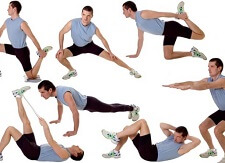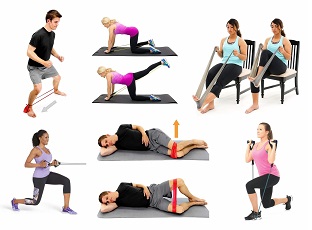- Home
- Knee Exercise Guide
- Knee Stretches
- Piriformis Stretches
Piriformis Stretches
Written By: Chloe Wilson, BSc(Hons) Physiotherapy
Reviewed by: KPE Medical Review Board
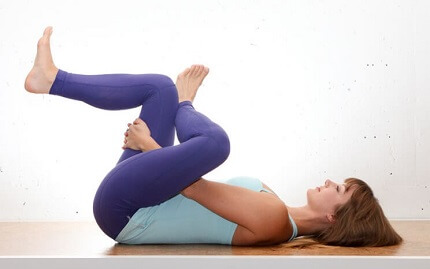
Piriformis stretches can help anyone suffering from back, hip, knee or foot pain.
The piriformis muscles are found right in the middle of the each buttock, deep underneath your glutes.
Piriformis tightness can affect the way your hip moves and thus affect your knee and foot.
Piriformis tightness can also place pressure on the sciatic nerve, which runs directly through the muscle causing tingling, pins and needles, numbness and pain through the buttock and down the leg. This is known as piriformis syndrome.
Piriformis tightness can develop in anyone, from the office worker to the keen runner. Piriformis stretches help to relieve tightness in the muscle and pressure on the sciatic nerve and can help reduce back, hip, knee and even foot pain.
Here we will look not only at how to do piriformis stretches, but also answer your most frequently asked questions:
- What Causes A Tight Piriformis?
- What Does A Tight Piriformis Muscle Feel Like?
- How Should I Sit To Avoid Piriformis Syndrome?
- What Is The Fastest Way To Fix Piriformis Syndrome
How To Stretch Piriformis
There are lots of different ways you can do piriformis stretches. Finding the right one for you will depend on your starting point, for example a middle aged office worker will stretch differently to a young gymnast.
Here you will find loads of different ideas for how to stretch piriformis. Try them out and pick the two that you feel works best for you. Once you’ve found the right ones for you, aim to do them 3 times each, 1-2 times each day. After a couple of weeks, you should start to notice a real improvement.
If you are already pretty flexible i.e. can touch your toes without bending your knees and can comfortably sit crossed legged, then I suggest you start with the piriformis stretches headed in pink. If you feel pretty tight all over, I suggest starting with those in blue.
1. Lying Piriformis Stretch
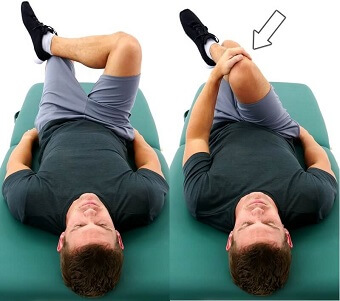
- Lie on your back with one knee bent with the other leg crossed over on top of the opposite knee
- Pull the knee across your body towards the opposite shoulder until you feel a stretch
- Hold for 30 seconds, gradually drawing your knee further over as you feel your piriformis release
- Keep both hips anchored on the floor – don’t let your body start to roll over
- For an even great piriformis stretch, as you draw the knee over let your foot lift up off the opposite knee
2. Modified Piriformis Stretch
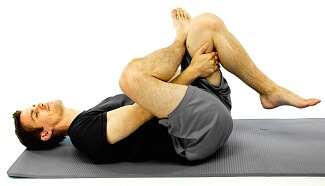
- Lie on your back with your knees bent and cross one foot over onto the opposite knee
- Hold the back of that knee and pull your knee towards your chest until you feel a strong stretch in the middle of your buttocks – that’s your piriformis stretching
- Hold for 30 seconds, gradually drawing your knee closer to you as your piriformis muscle stretches
3. Double Handed Piriformis Stretch
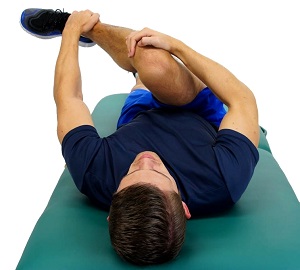
- Lie on your back with one knee slightly bent and grasp the other knee and foot with your hands
- Pull your foot and knee up and over to bring the knee across towards the opposite shoulder
- Hold for 30 seconds, gradually bringing the knee and foot further over
- Avoid rocking over onto your side, keep your lower back anchored to the floor
4. Seated Piriformis Stretch
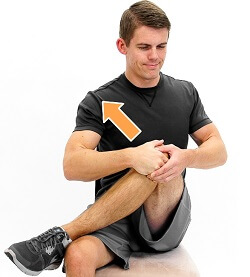
- Sit on a firm chair and cross one foot over onto the opposite knee
- Draw the top knee across to the opposite shoulder keeping your foot resting on the bottom knee
- Hold for 30 seconds, gradually increasing the stretch by drawing the knee further over
- Try not to slump back but aim to sit up straight to increase the stretch
5. Seated Pretzel Stretch
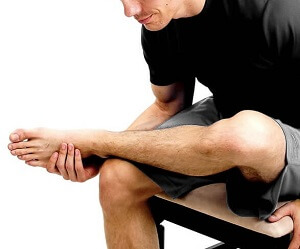
- Sit in a firm chair and cross one foot over on top of the opposite knee
- Slowly lean forwards until you feel your piriformis stretching
- Hold for 30 seconds gradually trying to lean further forwards
- You can increase the stretch further by either pushing down through the crossed knee or leaning across to the opposite side
6. Foam Roller Piriformis Stretches
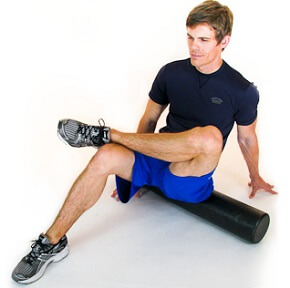
- Sit on top of a firm foam roller and cross your foot onto the opposite knee
- Lean over slightly towards the crossed knee until you feel a stretch
- Then gently roll backwards and forwards slightly on the roller feeling the extra pressure through the piriformis
- Spend 1-2 minutes doing this and repeat
If you don’t have a foam roller, try using a tennis ball instead. Sit with the tennis ball under the middle of your buttock and do the exercise as described. The pressure through the ball with target the stretch to the piriformis
7. Standing Piriformis Stretch
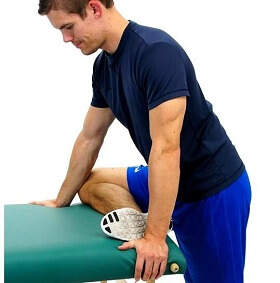
- Stand facing a table or high stool and place one leg up as shown
- Lean forwards slightly, using the table for balance, until you feel your piriformis stretching
- Hold for 30 seconds gradually leaning further forwards
- You can increase the stretch by bending your standing knee and doing a mini squat
Your Questions Answered
What Causes A Tight Piriformis Muscle?
A tight piriformis muscle is usually the result of muscle imbalance. Typically, there is weakness in the glutes and core abdominal stabilisers which may be accompanied by overactive, tight hamstrings. This muscle imbalance not only makes subtle changes to hip position which affects the pull on piriformis, but actually encourages piriformis to work harder and tighten in an attempt to counteract the surrounding weakness.
Muscle tightness often develops in response to muscle weakness – if a muscle is weak, it can’t provide enough support so the surrounding muscles gradually tighten up to try and provide the missing support.
So another really important element of rehab with piriformis tightness is to strengthen the main stabiliser of the hip, gluteus medius. If you stretch muscles without strengthening the stabilisers you can actually end up with more problems as you take away what support the joint has.
A tight piriformis muscle often goes hand in hand with hamstring tightness, particularly in men.
So as well as doing piriformis stretches, it is also really important to do hamstring stretches and glutes strengthening, so that piriformis can relax, otherwise no matter how many piriformis stretches you do, chances are it will keep tightening right back up in between.
Other things that can cause a tight piriformis muscle are
- Leg Length Discrepancy: having one leg slightly longer than the other
- Over-Exercising: particularly if you suddenly increase how much you exercise
- Hip Problems: previous hip injuries or surgery
- Knee Problems: muscle weakness or knee injuries
- Foot Problems: such as reduced foot arch height
What Does A Tight Piriformis Feel Like?
A tight piriformis usually causes a strong aching sensation in the buttocks, particularly when sitting down for long periods e.g. in the car. Piriformis tightness can often squash the sciatic nerve resulting in piriformis syndrome.
Compression of the sciatic nerve with piriformis syndrome usually causes tinging, pins and needles and numbness in the buttocks and down the back of the leg that may extend down to the back of the knee. Symtoms of piriformis syndrome tend to get worse when climbing stairs, squatting down or with prolonged sitting.
How Should I Sit To Avoid Piriformis Syndrome?
Many of us spend a lot of time sitting down each day. Sitting in the wrong position or on the wrong chair can increase the likelihood of piriformis tightness
- Chair Height: Your chair should be high enough that your hips are level with or slightly higher than your knees. Sitting in a low chair, or a soft chair that you sink into, where your knees are higher than your hips increase the pressure on the piriformis muscle and can result in tightness. Sitting on a cushion can help not only to raise your hips but also to provide some cushioning through your buttocks.
- Take Regular Breaks: Every 20-30 minutes stand up and have a quick walk around. Our bodies weren't designed to stay still, they are designed to move and be active. You'll be amazed what a difference it makes to take quick breaks from sitting, not just in helping to reduce piriformis tightness but also to improve your posture and reduce back and neck pain.
- Posture: To avoid piriformis tightness, make sure you sit right at the back of your chair. Place a rolled up towel or small cushion in the small of your back to stop your slouching forwards. Tuck your chair in so that your shoulders are directly above your hips, rather than bent forwards. It can help to clench your glute for a few seconds every 15 minutes or so (you could set a reminder on your phone/computer to pop up to remind you) to get you back into a good posture.
Another thing that can help reduce piriformis pain when sitting is to alternate between sitting with your legs together and sitting with your knees wide apart (feet outside the chair legs). This helps to stretch out the hips and glutes and reduce some of the pressure through them.
What Is The Fastest Way To Fix Piriformis Syndrome?
If you are suffering from piriformis syndrome, you may want to try:
- Medication: talk to your doctor about pain medication and anti-inflammatories. Whilst they won't cure piriformis syndrome, they will help to reduce the pain.
- Heat Pack: It can really help to place a heat pack over the piriformis muscle to help it relax and to improve blood flow to the area. This brings in fresh oxygen and nutrients to the muscle and sciatic nerve and helps reduce pain and tension in the buttocks.
- Exercises: One of the best ways to fix piriformis syndrome is to do the right exercises. Remember, you want to do a combination of piriformis stretches, hamstring stretches and glutes strengthening.
- Steroid Injection: If you are having ongoing problems with piriformis syndrome, it can help to have a corticosteroid injection into the area to reduce pain and inflammation.
- Correct Posture: Work on improving your posture when sitting down by thinking about your desk set up and the chairs you are using (including your car), and when standing, particularly if you have a leg length discrepancy or altered foot biomechanics.
- Physical Therapy: A physical therapist can not only help treat the symptoms of piriformis syndrome, they will also carry out a comprehensive assessment to highlight any underlying issues contributing to piriformis pain e.g. muscle imbalance, altered foot biomechanics and core instability.
Most people make a full recovery from piriformis pain. The earlier treatment starts, the quicker recovery will be so get going with those piriformis stretches today!
Summary
- Find the piriformis stretches that work best for you – pick your favourite two
- Hold each stretch for 30 seconds and repeat 3 times
- Aim to do your stretches at least once a day, preferably twice
- Remember, when you do piriformis stretches, it should feel tight and sore in your buttock, but that discomfort should settle quickly once you release the stretch
- Make sure you do hamstring stretches and glutes strengthening alongside your piriformis stretches to get the best results
Page Last Updated: 18/01/23
Next Review Due: 18/01/25
Related Articles
Exercise Top Tips
December 7, 2023
How To Stretch
January 11, 2023
Resistance Band Exs
December 7, 2023
